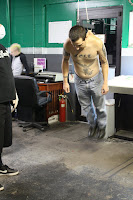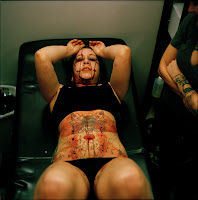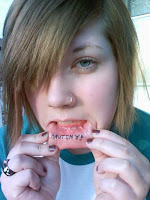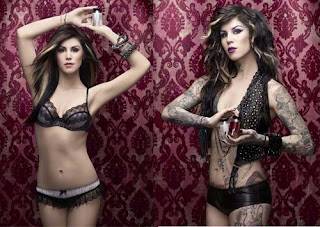Ear Gauging is a gradual process of stretching your ear piercing. You could easily get your ears pierced with a larger gauge needle. Gauging your ear piercings is a better option than losing a good bit of your ear. For the most part, later on in life if you're not happy with the stretching, you can simply remove the jewelry and after a while your piercing will return to a smaller size. However, there are exceptions to that once you pass a certain size. One thing more people should be aware of is that once you stretch your ears past a certain point your only option to have them return to a smaller size is through surgery.
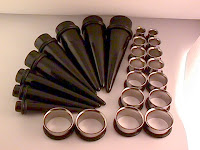 There are different ear gauge sizes. Standard size ear piercings are usually done with an 18g or 20g needle. Smaller the gauge size...larger the hole. To stretch existing ear piercings, tapering rings and tapering inserts, usually made of metals like gold, silver or steel, are used. As their name indicates, these devices taper along their lengths from small to big and can be used according to requirement.
There are different ear gauge sizes. Standard size ear piercings are usually done with an 18g or 20g needle. Smaller the gauge size...larger the hole. To stretch existing ear piercings, tapering rings and tapering inserts, usually made of metals like gold, silver or steel, are used. As their name indicates, these devices taper along their lengths from small to big and can be used according to requirement. On your own, especially if you have little or no experience, there is a chance you might hurt yourself and end up with an infection or a scar. Then go easy and have patience with the whole process. Go from one gauge size to another gradually and allow as much time as needed for your earlobe to heal in between. This can take anything from one week to two or more. It really varies from person to person. The process of gauging your ear piercing is slow and gradual, but that beats going about with your ears heavily bandaged. What you should do is select a gauge size that is next in size to your current one and buy metal earrings or insertion tapers in that next gauge size. Metal ones are a better idea than ones made of other materials as the chances of infection are considerably reduced.
On your own, especially if you have little or no experience, there is a chance you might hurt yourself and end up with an infection or a scar. Then go easy and have patience with the whole process. Go from one gauge size to another gradually and allow as much time as needed for your earlobe to heal in between. This can take anything from one week to two or more. It really varies from person to person. The process of gauging your ear piercing is slow and gradual, but that beats going about with your ears heavily bandaged. What you should do is select a gauge size that is next in size to your current one and buy metal earrings or insertion tapers in that next gauge size. Metal ones are a better idea than ones made of other materials as the chances of infection are considerably reduced.To start the gauging process...Do one ear at a time. Go very carefully as they are not going to slide through at once and you don't want to tear your ears. Manipulate the holes using medicinal soap and warm water. After you finish inserting the tapers, dry your earlobes, apply a little petroleum jelly, and leave your ears to get used to the new, unaccustomed weight. Your ears will feel sore for a couple of weeks until they get used to the new size. Keep the piercing holes clean by washing them gently twice a day and be sure to dislodge the crusty formation daily. Disinfect the taper inserts too with a regular application of alcohol. With enough care and patience you shouldnt have any problems. The tapers will stretch your ears as required. You know your ear holes have stretched when you are able to move the earrings about easily and without experiencing any discomfort. It could take you up to two weeks to reach this stages. Wait until your ears are fully healed before you start wearing regular ear jewelery. If you want an even larger ear piercing, then just repeat the entire process with the next ear gauge size. Although, one thing to be very careful of is jumping sizes. You really shouldnt jump more than 2 sizes when gauging. That can result in tearing your ears, and no one wants that.
On of the best things to use on freshly done piercings as a cleanser is...warm salt water. Believe it or not. There are alot of fantastic known healing properties of Sea Salt. One product that is sold specifically for tattoos and piercing aftercare that contains sea salt is H2Ocean. It may be a little more expensive...but entirely worth it.











